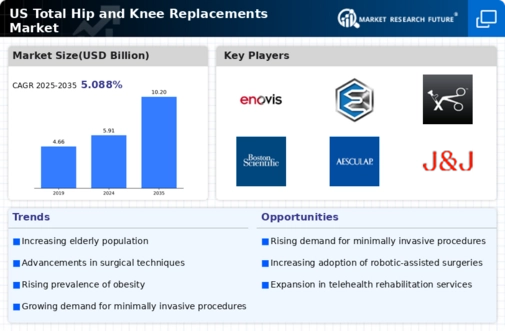The total hip-knee-replacements market is characterized by a competitive landscape that is increasingly shaped by innovation, strategic partnerships, and a focus on patient-centric solutions. Key players such as Johnson & Johnson (US), Stryker Corporation (US), and Zimmer Biomet (US) are at the forefront, leveraging their extensive research and development capabilities to enhance product offerings. Johnson & Johnson (US) emphasizes a robust pipeline of minimally invasive surgical solutions, while Stryker Corporation (US) focuses on integrating advanced robotics into their surgical systems. Zimmer Biomet (US) appears to be concentrating on expanding its digital health solutions, which collectively contribute to a dynamic competitive environment where innovation is paramount.
In terms of business tactics, companies are increasingly localizing manufacturing to reduce lead times and enhance supply chain efficiency. The market structure is moderately fragmented, with several players vying for market share, yet the influence of major companies remains substantial. This competitive structure allows for a diverse range of products and services, catering to varying patient needs and preferences, while also fostering an environment ripe for collaboration and innovation.
In October 2025, Stryker Corporation (US) announced the launch of its latest robotic-assisted surgical system, which is designed to improve precision in hip and knee replacement surgeries. This strategic move is significant as it not only enhances Stryker's product portfolio but also positions the company as a leader in the growing trend of robotic surgery, potentially increasing its market share in a highly competitive field. The integration of robotics into surgical procedures is likely to attract a broader range of healthcare providers seeking to improve patient outcomes.
In September 2025, Zimmer Biomet (US) unveiled a new digital platform aimed at streamlining the surgical workflow for orthopedic procedures. This initiative reflects the company's commitment to digital transformation and highlights the increasing importance of technology in enhancing surgical efficiency. By providing surgeons with real-time data and analytics, Zimmer Biomet (US) is likely to improve surgical outcomes and patient satisfaction, thereby reinforcing its competitive position in the market.
In August 2025, Johnson & Johnson (US) entered into a strategic partnership with a leading telehealth provider to enhance post-operative care for hip and knee replacement patients. This collaboration underscores the growing trend of integrating telehealth solutions into traditional surgical practices, aiming to improve patient monitoring and recovery processes. Such partnerships may not only enhance patient engagement but also reduce hospital readmission rates, which is a critical factor in the overall success of surgical interventions.
As of November 2025, the competitive trends in the total hip-knee-replacements market are increasingly defined by digitalization, sustainability, and the integration of artificial intelligence (AI) into surgical practices. Strategic alliances are becoming more prevalent, as companies recognize the value of collaboration in driving innovation and improving patient outcomes. Looking ahead, competitive differentiation is likely to evolve from traditional price-based competition to a focus on technological advancements, innovative solutions, and reliable supply chains, which will be essential for sustaining market leadership.

















Leave a Comment